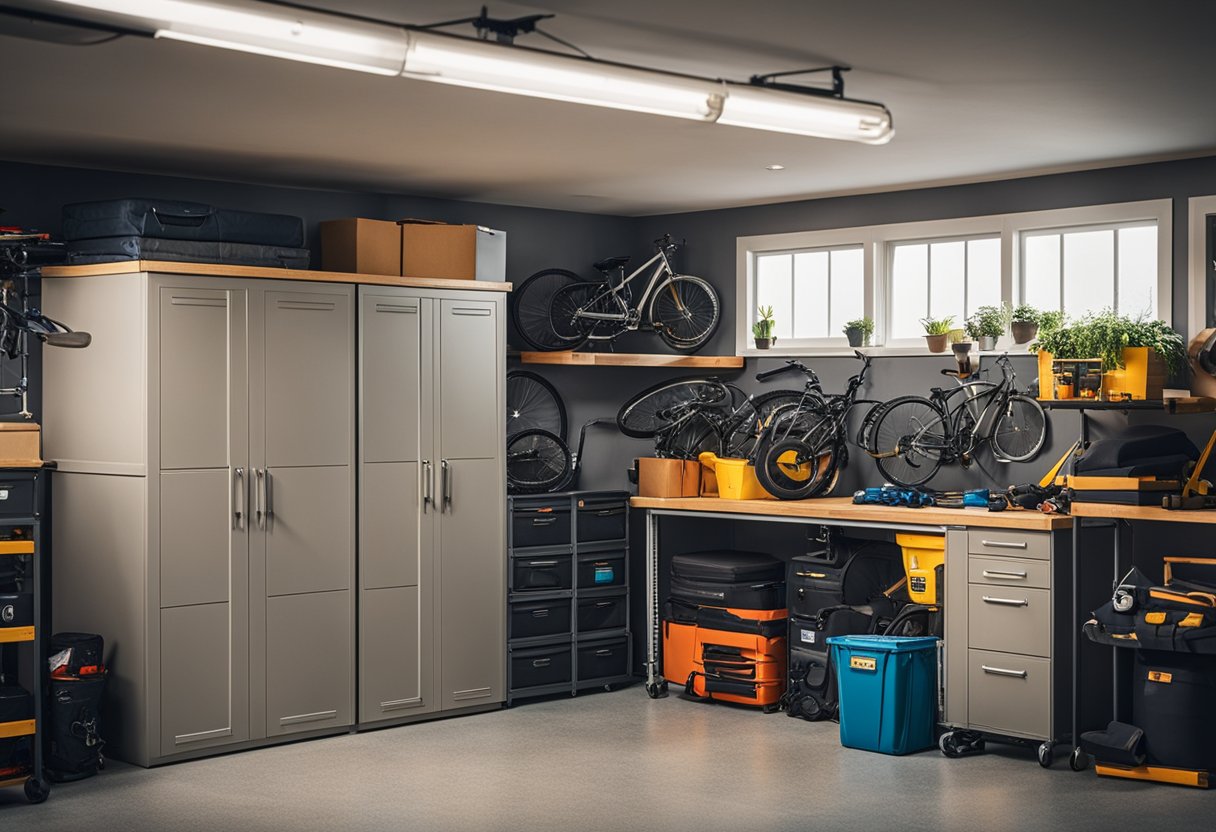The process of downsizing can be challenging and emotional, as it often requires parting with cherished possessions, adjusting to a smaller living space, and navigating the practical aspects of packing and moving. However, when approached with the right mindset and equipped with useful guidance, downsizing can also be a liberating and rewarding experience. It can help you feel more in control of your life, reduce unnecessary stress, and allow for a fresh start tailored to your current and future needs.
Key Takeaways
- Downsizing for seniors should be approached with careful planning and organization to minimize stress and maximize efficiency.
- Elements of simplifying life include decluttering belongings, managing finances, and adjusting to a new living space or community.
- Keeping safety, sentimental value, and organization in mind can help create and maintain a simplified lifestyle in your senior years.
Downsizing Tips: Understanding the Process
As I began my journey into my senior years, I realized that downsizing was an important aspect to embrace. In essence, downsizing means trading a larger living space for something smaller and more manageable. For seniors, it often signifies a transition in lifestyle, from a potentially cluttered home full of memories to a more simplified and easy-to-maintain environment.
The process of senior downsizing can be both physically and emotionally challenging. Thus, it is crucial to give oneself ample time to adapt to the idea and to properly sort through belongings to make the transition smooth.
In my experience, the key to a successful downsizing lies in the initial planning stages. It helped me to create a detailed plan of action, starting with a thorough assessment of my needs and wants regarding living space, possessions, and financial considerations. From there, I prioritized and made decisions about what to keep, discard, or donate.
Once the initial planning stage was complete, I found breaking the downsizing process into manageable tasks made it much easier. For example, setting aside specific days or time frames to sort through one room at a time helped. This gradual approach allowed me to tackle the task systematically and without feeling overwhelmed.
Finally, one important aspect of downsizing is finding the right size home to suit my needs. Smaller living spaces, like condos or apartments, offer the convenience and affordability I was looking for, without compromising on quality living.
Through downsizing, I found not only a sense of relief from the burden of maintaining a large home but also a newfound appreciation for the simplicity and ease that comes with a smaller living space.
Initiating the Downsizing Process
In my experience, starting the downsizing process early is essential for a smooth transition. I usually recommend beginning at least two to three months in advance. This not only helps to avoid last-minute stress, but also provides ample time to sort through belongings and make well-considered decisions.
I find it crucial to devise a detailed plan before starting the downsizing journey. Having a clear vision of the tasks ahead makes the relocation process more manageable and enjoyable. To help me stay organized, I create a downsizing checklist that includes all essential tasks, from sorting and decluttering to packing and moving. This checklist has helped me stay on track and ensure nothing gets overlooked.
As I plan, I establish a realistic timeline to accommodate the various stages of downsizing. In doing so, I try to be flexible and expect that some tasks may take longer than anticipated. This helps me avoid unnecessary stress and ensure that I allocate enough time for each aspect of the process.
During the planning phase, I prioritize assessing my belongings to determine what truly has value in my new, simplified living situation. This part of the process can be both emotional and time-consuming, but it’s essential to make well-considered decisions about what to keep, sell, donate, or discard.
In conclusion, initiating the downsizing process can be an exciting and empowering journey when done right. By starting early, creating a plan, and using a downsizing checklist, I can ensure a smooth transition to a simpler life in my senior years. Remember, staying organized and managing your time wisely are key components to downsizing success.
Methods for Simplifying Your Life
As I’m entering my senior years, I’ve found that simplifying and downsizing my life has become increasingly important. It not only helps to declutter my living space, but also promotes a sense of organization and tranquility. In this section, I will address a few methods that I’ve found useful in achieving a simpler lifestyle.
One effective strategy I’ve implemented in my senior simplifying journey is evaluating and processing the reasons for downsizing. This involves having an honest conversation with myself about my needs and long-term objectives, allowing me to prioritize my belongings accordingly.
To begin decluttering, I found it useful to start early, giving myself ample time to sort through my belongings and make thoughtful decisions. Experts suggest beginning the process at least two to three months in advance to avoid being rushed or overwhelmed.
Creating a plan is another essential step in my organizing efforts. By outlining the specific areas I want to tackle and setting attainable goals, I’ve been able to maintain motivation and stay on track. Additionally, I realized that involving friends and family can make the process more enjoyable and supportive.
Using a simple organization system has been key in decluttering my space. I typically sort items into categories, such as keep, donate, or discard. This helps me to visualize the progress I’m making and encourages me to part with possessions I no longer need. Moreover, focusing on one area of my home at a time allows me to make steady progress without feeling overwhelmed.
Lastly, finding creative ways to reorganize my living space has been incredibly helpful in simplifying my life. By utilizing storage solutions, such as shelves, bins, and hooks, I’ve been able to maximize my available space and create a more organized home.
By implementing these methods, I’ve discovered that senior simplifying is not only about downsizing belongings, but also creating an environment that promotes a sense of peace and well-being in my golden years.
Packing and Moving Tips

In my experience, the key to a successful downsizing process is proper planning and efficient packing and moving. First and foremost, I recommend starting at least two to three months in advance, as this gives ample time to carefully sort and declutter belongings. Creating a detailed plan makes the relocation process much more manageable and enjoyable.
When packing, I find it helpful to systematically categorize my belongings. Organizing items based on their functional purpose or the room they belong to can simplify the moving day. Don’t forget to label the boxes clearly; it saved me so much time when unpacking. Also, enlisting the help of family members or friends can relieve the moving stress and make the process smoother.
As I downsized, I realized the importance of prioritizing maintenance. The new living space may require some upkeep or even repairs. Arranging for professionals to handle maintenance tasks before the moving day saves time and ensures that I moved into a comfortable and well-maintained home.
Lastly, I’d like to stress the importance of self-care during this transition. Downsizing can be a challenging and emotional experience. Taking breaks while packing and organizing, and staying hydrated and well-fed during the process has significantly reduced my moving stress.
Overcoming Sentimental Hurdles

As I began the process of downsizing in my senior years, one of the more challenging obstacles I faced was dealing with sentimental items. It’s essential to recognize and overcome these sentimental hurdles to simplify your life and make the transition smoother. In this section, I’ll share some strategies I found helpful when sorting through belongings with emotional significance.
When going through my belongings, I realized that many items held sentimental value, like old photographs, memorabilia, and collections. To manage this, I started by taking photos or scanning the items I felt strongly connected to, allowing me to keep a digital record without holding onto the physical object. This method helped me let go of some sentimental items while still preserving memories associated with them.
Another approach I took was setting limits for myself. I allocated a specific storage space, such as a memory box, for these treasured items and decided that whatever didn’t fit into it must be let go. This approach also made room for newer experiences and possessions as I moved forward in my life.
During the process, I found it helpful to share stories and memories associated with my belongings with friends or family members. It not only provided an opportunity to reminisce but also gave my loved ones a chance to understand the emotional significance of these items. In some cases, I decided to pass on these precious items to people who would appreciate and cherish them, ensuring my memories live on in their hearts.
Lastly, I reminded myself that letting go of belongings doesn’t mean I’m losing the memories that come with them. It’s essential to be confident in my decision to downsize and focus on the benefits of simplifying my life. By acknowledging these sentimental hurdles and finding effective ways to overcome them, I have made significant progress in my downsizing journey.
In summary, sorting through sentimental items can be a challenging and emotional part of downsizing, but by setting limits, documenting memories, sharing stories, and passing on treasures to loved ones, it becomes easier to make these tough decisions and move towards a simpler, more organized life in my senior years.
Organizing New Space

As I prepare to move into my new space, it’s essential to have a clear understanding of the floor plan. By getting acquainted with the layout, I can make better decisions on organizing belongings and allocating storage. When I have a grasp of the dimensions and configuration of each room, it becomes easier to create an organized and functional home.
As a senior looking to simplify life, it’s important for me to prioritize my belongings and determine which items are essential and which can be let go. I can start by decluttering and sorting my possessions into categories: keep, donate, and discard. This process allows me to make room for the things that truly matter and create a more manageable living environment.
Maximizing storage space is crucial for maintaining an organized home in my senior years. This involves identifying efficient storage solutions such as shelves, cabinets, and storage units that allow me to keep my belongings easily accessible yet neatly stored. Utilizing vertical spaces, multifunctional furniture, and proper measurement techniques can contribute greatly to achieving a clutter-free and organized living area.
When it comes to organizing my new space, consistency is key. Establishing routines for maintaining order and cleanliness, such as regularly decluttering, can significantly contribute to sustaining a simplified and harmonious living environment. By being intentional and mindful with the arrangement of my belongings, I can create a space that supports a more comfortable and efficient lifestyle in my senior years.
Downsizing to Senior Living Community
As I began the process of downsizing, I realized that moving to a senior living community can provide various benefits. One significant advantage is the reduced financial burden, as I could stop paying for home maintenance expenses, home insurance, and property taxes. This made moving to a community more affordable for me. To make this transition smoother, I followed a step-by-step process.
At first, I started by devising a plan and setting a timeline for my move. I focused on sorting my belongings into categories, like items to keep, items to donate, and items to discard. This method helped me declutter my home and make it more manageable to pack.
In searching for the ideal senior living community, I considered various factors, such as the available amenities and the level of care offered. Senior living communities come in different types, like retirement communities, assisted living facilities, and memory care centers. I made sure to visit several communities to compare their services and living spaces.
When selecting a senior living community, I paid attention to the social aspects as well. I looked for communities with engaging activities and programs, giving me opportunities to interact with other seniors and lead an active lifestyle. This aspect is crucial for my overall well-being and happiness.
As I prepared for the move, I found it essential to communicate with family and friends, keeping them updated on my plans and asking for their support. This not only helped me emotionally but also made the transition more manageable since they could offer practical assistance when needed.
By taking a systematic approach to downsizing and choosing the right senior living community, I’ve managed to simplify my life in my senior years significantly. The transition, though challenging, has provided me with an opportunity to embrace a more comfortable, leisurely lifestyle in a supportive environment, surrounded by other seniors with similar interests and needs.
Managing Documents and Paperwork

When it comes to downsizing and simplifying life in your senior years, one crucial aspect to take into account is managing documents and paperwork. I believe that having an organized system for this task can make the process significantly easier.
Firstly, I recommend gathering all the important documents, such as birth certificates, insurance policies, and medical records. Having these essential items in a single, secure location, like a safe deposit box or fireproof safe, will ensure they are easily accessible when needed. You can also digitize your paperwork by scanning the documents and storing them on a secure cloud service or a password-protected device. This way, I can access them from anywhere and declutter my living space at the same time.
While going through my paperwork, I find it helpful to take an inventory of the documents I have. This allows me to quickly identify and discard any duplicates or unnecessary paperwork, such as old receipts or expired warranties. Creating an inventory also gives me a clear picture of what type of documents I possess, making it easier to locate specific items in the future.
To keep my documents organized, I create a filing system according to my needs and preferences. For example, I separate my financial documents from my medical records and use different folders or binders for each category. Labeling these folders clearly makes it easy for me to find what I am looking for without too much hassle.
Managing documents and paperwork is a vital part of downsizing and simplifying life in my senior years. By following these steps, I am confident that my important documents will be secure, organized, and easily accessible whenever I need them.
Effective Usage of Garage and Storage Space

As I continue with my downsizing journey, I’ve learned the importance of effectively using my garage and storage space. The key is to be selective about what I store and find innovative solutions to keep everything organized. In this journey, I found a few useful tips to maximize my garage and storage space.
Firstly, I suggest investing in space-saving furniture. I’ve personally benefited from using furniture pieces that serve multiple functions, like a bed with built-in storage or a foldable wall-mounted table. These types of furniture can save a substantial amount of space while still providing adequate storage.
In my garage, I found it helpful to install shelves and hooks on the walls. This way, I can store items vertically, freeing up valuable floor space. Also, I utilize sturdy storage containers and label them clearly to help me quickly locate my belongings when needed.
My downsizing experience has taught me the importance of decluttering regularly. By staying on top of clutter, I can maintain an organized home and avoid feeling overwhelmed. One useful strategy I’ve adopted is the one-in, one-out rule: whenever I bring a new item into my home, I make sure to let go of another.
Finally, I’ve discovered that stackable storage containers are a great solution for maximizing space. These containers allow me to store items safely and compactly. Clear containers are especially useful, as they make it easy for me to see what’s inside without having to open each one.
As a senior simplifying my life, I’ve found these tips to be incredibly helpful in making the most of my garage and storage spaces. By staying organized and utilizing space-saving solutions, I can enjoy a simplified and stress-free environment in my golden years.
Reducing Repetitions and Duplicates
As I downsize and simplify my life in my senior years, I’ve found that one key area to focus on is reducing repetitions and duplicates. When I started sorting through my belongings, I quickly realized that I had multiple copies of the same item or very similar items that serve the same purpose. To make my downsizing process more efficient and effective, I’ve applied some strategies to help me identify and deal with these repetitions and duplicates.
Firstly, I go through each room in my house and create a list of items that I commonly find in multiples. This includes kitchen utensils, linens, clothing, and even books or DVDs that I’ve collected over the years. By creating this inventory, I can easily spot what items I have too many of, and decide which ones I should keep, donate, or discard.
When it comes to choosing which items to keep, I prioritize my favorites and the ones in the best condition. For example, if I have four nearly identical sets of bedsheets, I’ll keep the ones that are in the best shape, have the most comfortable fabric, or hold sentimental value.
Another tip for reducing repetitions and duplicates is to organize items into categories, such as clothing, kitchenware, or decor. I found that removing duplicate items makes it easier to declutter and downsize. By categorizing and sorting through each group of belongings, I can see the progress I’ve made in decluttering and avoid being overwhelmed.
Finally, while downsizing, I remind myself that my goal is to create a simpler and more manageable living space. By reducing repetitions and duplicates, I can achieve this without sacrificing the things that are most important to me. Keeping my priorities in mind, downsizing becomes a more enjoyable and fulfilling experience, as I focus on my new chapter in life with a streamlined, clutter-free home.
Budgeting and Financing Downsizing

When it comes to downsizing and simplifying my life in my senior years, budgeting and financing play a pivotal role. To ensure a smooth transition, I start by determining the budget required for this process.
I begin by determining the budget for my new living space. This involves considering factors such as location, amenities, and housing type. Assessing my income, savings, and expected expenses post-downsizing will help me identify a comfortable budget range. Also, I need to factor in costs associated with selling my current home, like fixing up the place, real estate agent fees, and closing costs.
Next, I plan for the actual moving process. This includes listing and organizing my belongings, hiring professionals or asking family members for assistance, and budgeting for packing supplies or services. By decluttering and donating or selling items that I no longer need, I can significantly reduce the volume of possessions to move and potentially earn some extra cash.
Many seniors find that they save money by downsizing their living space. The smaller the house, the lower the maintenance, utility, and tax expenses. To determine how much I can save, I perform a month-by-month comparison of my current and anticipated expenses.
Finally, I research financial assistance programs aimed at seniors to help ease the downsizing process. There are several government and non-government programs that provide financial support for retirement, like Social Security, Medicare, and veteran benefits. Exploring these options can offer valuable insights to make downsizing more practical and budget-friendly.
By carefully budgeting and financing the downsizing process, I can achieve the goal of simplifying my life and enjoying a more comfortable and enjoyable senior living experience.
Safe and Successful Moving

I believe that a smooth moving process is essential when downsizing and simplifying life in your senior years. One of the key aspects of this process is ensuring safety and proper transportation for everyone involved.
When planning for the moving day, I prioritize safety by using proper lifting techniques and creating a clear pathway in and out of my home. I make sure to avoid heavy boxes and enlist the help of friends, family members, or professional movers when necessary. This can greatly reduce the risk of accidents and injuries during the moving process. Furthermore, I pay close attention to transportation details, ensuring that my belongings are secured and protected during the move. I also choose to work with a reputable moving company that has experience assisting seniors with mobility challenges.
As I proceed with the moving process, I find it helpful to keep track of my important documents, such as medical records, financial information, and any legal paperwork. This ensures that I have all the necessary information accessible when settling into my new space. I also consider the mobility aspect of downsizing by selecting a home that is senior-friendly, with features such as accessible entryways, single-story living, and handrails in the bathroom.
During the entire downsizing and moving process, I strive to maintain a confident and knowledgeable approach, making informed decisions based on my own research and the advice of professionals in the field. By following these strategies, I can rest assured that I’m taking the necessary steps towards a safe and successful move into a simplified life during my senior years.
Frequently Asked Questions
What are the best strategies for decluttering in retirement?
I recommend tackling one room at a time to break the task into manageable portions. Consider creating categories for your belongings, such as “keep,” “donate,” or “discard.” Don’t be afraid to ask for help from family members or friends and remember to give yourself enough time to complete the process. Starting early allows you to downsize effectively without feeling rushed.
How can seniors efficiently downsize their living space?
First, evaluate and process your reasons and timing for downsizing. Next, create a plan and a timeline. Keep in mind the size of your new living space when deciding on what to keep or discard. Get practical with the use of storage solutions and consider repurposing or dual-use items.
What should be avoided when downsizing?
Avoid procrastination and indecisiveness. It’s better to make decisions and sort items sooner rather than later. Be mindful not to take on too much at once and take breaks when needed. When in doubt, consult with friends, family, or professionals for guidance.
What are the key steps to simplifying life as a senior?
To simplify your life as a senior, prioritize your belongings and living situation. Determine what brings you joy and functionality, then focus on keeping those items. Take time to evaluate and adapt your daily routines, and let go of unnecessary responsibilities. Embrace support from loved ones or senior living communities to help ease the transition process.
How can a senior transition to a smaller home effectively?
Start by envisioning your new living space and deciding what items to keep, donate, or discard. Measure your new home and plan where furniture and belongings will fit. Be prepared to organize and pack your possessions with efficiency and enlist the help of others as needed.
What are some essential downsizing tips for seniors?
Key downsizing tips include starting early, breaking tasks into manageable portions, enlisting support from others, staying organized, and keeping in mind the size and layout of your new living space. Don’t forget to maintain a clear vision of your end goal and adapt as necessary during the process.






